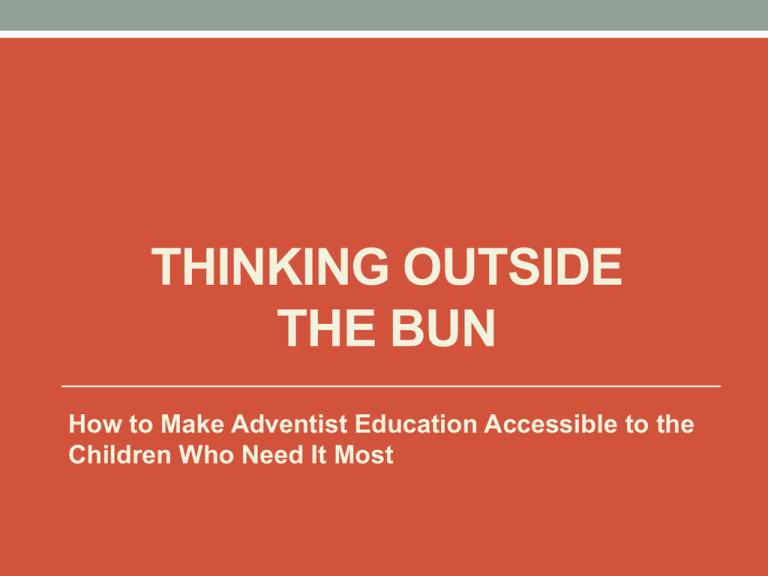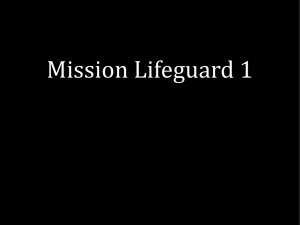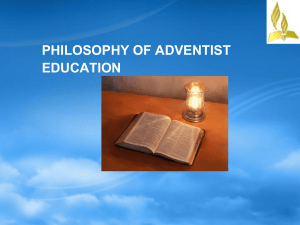Thinking Outside the Bun How to Make Adventist Education
advertisement

THINKING OUTSIDE THE BUN How to Make Adventist Education Accessible to the Children Who Need It Most Introduction – Adventist connections • 3rd Generation Adventist • PK & Married to a PK • Both my wife and I have 18 years of SDA education • M.Div and ordained pastor • Taught sociology at Andrews • VP for Academic Affairs at Antillean Adventist Univ • Since 2005 have served as a trustee at Andrews University • My two sons have spent 16 & 18 years in SDA education • Currently an Elder at a local Hispanic Adventist church MAIN ARGUMENT The likelihood of Adventist education surviving into the future depends in large part on whether those who are least able to afford it have access to it. Summary of Main Points 1. All kids can learn at high levels 2. There is demand for schools that close achievement gap 3. Teachers are the major drivers of learning 4. Data-driven education system is key to sustainability 5. Thinking outside the bun—innovation is future of Adventist education AGENDA 1. 2. 3. 4. 5. 6. 7. 8. 9. Mission of SDA Education The Killing of Adventist Education The Browning of Adventism Educational disparities and the experience of Adventist education Learning from the Catholic school systems Teacher quality and data infrastructure Educational innovation in Adventism Ideas worth considering Conclusion “ . . . the work of education and the work of redemption are one.” - EGW, EDUCATION, p.30 THRIVING CHILDREN Committed Churches Secure and nurturing families High-quality education “In a partnership that includes home, church, and school, we must commit to rebuilding and reemphasizing the reason we exist. We must work together—Sabbath school, church, Pathfinders, schools, and homes—to send the message to our youth that they are of utmost importance to us and that we will be working together for their salvation.” --Larry Blackmer THRIVING CHILDREN Committed Churches Secure and nurturing families High-quality education THE KILLING OF ADVENTIST EDUCATION How to Kill Adventist Education by Shane Anderson How to Kill Adventist Education by Shane Anderson 1. the lack of passion among churchgoing 2. 3. 4. 5. 6. members for being a “conservative” Seventhday Adventist; a misunderstanding of what constitutes biblical discipleship; poor pastoral support of Adventist education; poor parenting; the inroads of postmodernism, secularism, and “liberalism” in Adventism poor-quality schools THE BROWNING OF ADVENTISM Latino Population in the US • 49 M Latinos or 16% of population • 29 M born in the US • 20 M not born in US • (7 M citizens / 13 M noncitizens) • http://abcnews.go.com/ABC_Univision/News/fullpage/infographic-latinopopulation-growth-1850-19106482 the US Current Demographic Shifts • The future of Adventist education is being written in the current demographic shifts facing the Seventh-day Adventist Church. Increasing cultural and ethnic diversity are key markers that distinguish contemporary Adventism. Minority-Majority Denomination • Today, racial and ethnic populations now comprise well over half of the membership of the Adventist Church in the United States and Canada. The church in North America is a minority-majority denomination. Example - New York City • An estimated nine out of ten members of the church are people of color—mostly immigrants. • Ronald Lawson, “From American Church to Immigrant Church: The Changing Face of Seventh-day Adventism in Metropolitan New York,” Sociology of Religion 59, no. 4 (1998): 329–351. doi:10.2307/3712121. • Over the past thirty years, more than 75 percent of new converts in the North American Division (NAD) have come from “new immigrant” groups. • Ronald Lawson, “When Immigrants Take over: The Impact of Immigrant Growth on American Seventh-Day Adventism’s Trajectory from Sect to Denomination,” Journal for the Scientific Study of Religion 38, no. 1 (March 1999): 83–102. Latino Adventism • As of 2010, membership in NAD was 184,955, or about 17 percent of total membership. • Contributing well over $92 million in tithe. • Over the past ten years (2000–2010), the Latino Adventist church has grown at an incredible rate of 30 percent. • 1,165 Hispanic churches and companies led by a pastoral workforce of 539 strong. Latino Demographics • Estimate that there are more than 32,000 Latino young people under the age of 18 and that, among those, there are approximately 3,680 Latino children who attend Adventist schools. • Approximately 42.3 percent of Hispanic families earned less than $25,000 (poverty level) compared to 21.6 percent of the general Latino population EDUCATIONAL DISPARITIES AND THE EXPERIENCE OF ADVENTIST EDUCATION No Child Left Behind • Prior to NCLB: • only eleven states disaggregated achievement data by race, ethnicity, and gender; • only six states disaggregated for economically disadvantaged students; • only seven states disaggregated for English proficiency status; • only one state disaggregated for migrant students; • and only one state had a goal of narrowing the achievement gaps between any of these groups. NCLB & Religious Schools • NCLB provides resources to religious schools that may include a targeted, assisted pullout model, supplementary instruction, direct instruction, computer-assisted instruction, tutoring, counseling, and family literacy and early childhood programs. • In addition, the law requires equitable services for private school teachers of Title I students in professional development activities and of parents of Title I students in parent involvement activities. Impact of Poverty on Learning • Growing up in a poor family is the most significant contributor to the achievement gap. Parents with few resources are less likely to support the learning of their children. Unequal Childhood • The research shows that childrearing practices differ by the socioeconomic class of the parents and that those differences make a lasting impact on school readiness and other life outcomes. Extent of Poverty in Adventism • Poverty rates have remained quite steady, going from 36 percent in 2001 to 39 percent in 2007, and then to 35 percent in 2009. Compared with the poverty levels of the general American population (11.7 percent in 2001 and 14.6 percent in 2009) • The Adventist Church is more than twice as likely to have members living in poverty. This is a reality with significant consequences for the educational mission of the church. Cost of the Achievement Gap • Across grade levels, black and Latino students are two to three times more likely to have “below basic” skills in reading and math when compared to whites. • On average, black and Latino students are nearly three years of learning behind their white counterparts. All Children Can Learn at High Levels • Research has shown the children from disadvantaged backgrounds can learn at high levels • There are traditional public schools, charter schools, and private schools that are showing great success in closing the achievement gap • A zip code should not define the educational opportunities for a child. The Questions for Adventist Leaders are. . . • What kind of educational outcomes is the system producing among children from all racial, ethnic, and socioeconomic backgrounds? • Are there racial, ethnic, and income educational performance gaps among the children participating in Adventist education? • Or do all kids perform at the same level regardless of their racial or ethnic and income background? LEARNING FROM THE CATHOLIC SCHOOL SYSTEMS The Catholic educational system is the largest in US • 2,065,872 children enrolled in • 5,774 Catholic elementary schools • 1,206 secondary schools. Demographics of Catholic System • Almost a third (30.2 percent) or 624,878 of the children enrolled in the Catholic system are minority children. • Latinos - 13.1 percent, • Blacks - 7.4 percent, • Asians - 4.6 percent. • The number of non-Catholic students has grown from 2.7 percent in 1970 to 14.9 percent or 307,458 in 2011. Decline of Catholic Educ System • Since 2000 a total of 1,755 (or 21.5 percent) of schools were reported closed or consolidated, with a decline in student enrollment of 587,166 (22.1 percent) • Elementary schools in the twelve largest urban areas have declined by 23.2 percent since 2003 • If the trends continues over the next two decades, three thousand Catholic schools located in urban areas serving an estimated 900,000 children will close Value to Urban Communities “These schools are not just serving kids well. . . . A substantial proportion of them are rendering a huge national service by plugging away in very neglected neighborhoods where hardly any other social institutions work, including the public schools. It’s nothing short of heroic.” Karl Zinsmeister, Domestic Policy Advisor Why the Decline? 1. The integration of Catholics into mainstream 2. 3. 4. 5. 6. America; the movement of the middle class to the suburbs; fewer teachers who are religious (Nuns, Brothers); demographic shifts in church membership toward poorer Latino immigrant families; the emergence of charter schools that provide free high-quality school options to poor families; and the system’s resistance to change. Philosophical Assets • The Catholic system’s commitment to the poor and disadvantaged children even when they are not Catholic • “We don’t educate these children because they are Catholic, we educate them because we are Catholic.” Research & High Expectations • Openness to rigorous research and investigation. • Were it not for the long tradition of rigorous scholarship allowed by the system, the “Catholic advantage” would not have been documented. • Culture of high expectations • The focus of Catholic education on learning and academic achievement for all children runs up against the “soft bigotry of low expectations” prevalent in many troubled public urban schools. Refusal To Embrace Change Many Catholic schools are still bound to the same staid organizational framework developed generations ago. These systems are typically led by aging career Catholic educators lacking significant experience in any other field. Schools seldom have coherent content standards, accountability systems based on assessments of student academic growth, or an ethic of making publicly available the performance data that do exist. - Smarick, “Can Catholic Schools Be Saved?” 123. Cost Structure “How can schools with increasing costs survive when they serve predominantly lowincome students, and when they rely exclusively on tuition and private contributions for income?” Considering ‘Out of the Box’ solutions • Charter Catholic Schools • “The Catholic response has to focus on the children. That is what this framework does. It puts the children first.” Hamilton, ed., Who Will Save America’s Urban Catholic Schools? 92. Latinos as the future of Catholic schools • Catholic leaders now tout Latino outreach as one answer to the system's problems. The U.S. Conference of Catholic Bishops called on its schools to increase Latino outreach in a 2005 statement. Since then, dioceses around the country--including Boston, Cincinnati and Phoenix--have launched initiatives. • At the forefront of this effort is the Catholic School Advantage campaign, organized by the University of Notre Dame. It aims to double the number of Latinos in Catholic schools nationwide. The campaign works closely with parish schools in cities with large Latino populations, including New York, San Antonio and Los Angeles. • By Aaron Schrank, 2013 Religious News Service Other ‘Out of the Box’ solutions • Voucher systems • Religious Charter Schools • Catholics target Latinos TEACHER QUALITY AND DATA INFRASTRUCTURE It’s about high-quality teachers • Poor performance of teachers goes unaddressed by most schools across the country. • Ironically, the highest-need children attend schools with the worst teachers • In fact, the data is fairly consistent across districts—the kids with the greatest needs are the ones most likely to have the poorest performing teachers. Quality teacher w Lifetime Impact • The largest study ever conducted suggests that the impact of a good teacher on a child lasts a lifetime and impacts earning potential. - Raj Chetty, John N. Friedman, and Jonah E. Rockoff. “The LongTerm Impacts of Teachers: Teacher Value-Added and Student Outcomes in Adulthood,” Working Paper 17699, National Bureau of Economic Research, December 2011, http://www.nber.org/papers/w17699. Quality Teaching in Adventist Schools • How does the system determine who is an effective teacher? • Does the Adventist educational system use the latest analytical strategies to determine whether a teacher is effective or not? Data-driven Capacity and Culture • There is no data system infrastructure that tracks basic demographic information of the student and teacher populations within the K–12 Adventist educational system. • Need to better understand capacity and demand issues among school-attending age groups within the churches as well as assessing attitudes and commitment of adults toward the Adventist educational system. • Without a minimum threshold of accurate and reliable sources of information, decision making is left to conjecture and becomes a guessing game. CognitiveGenesis Results Summary Achievement of students in SDA Schools is: ABOVE AVERAGE in all subjects for all grade levels ABOVE PREDICTION in all subjects for all grade levels for all school sizes regardless of ability level Grade 8 Students (2006-2008 data) 75 Percentile Rank 70 65 60 55 National Average 50 45 40 0 (New Student) 1-2 3-6 7 (All Years) Number of previous years in Adventist schools Valuegenesis 1 &2 (completed) PhysicalGenesis (future) CognitiveGenesis (2006-2009) Research agenda for the future • Understanding the extent of the achievement gap • Does the “Adventist advantage” exists for all children. EDUCATIONAL INNOVATION IN ADVENTISM Ideas to Strengthen Adventist Education 1. Commitment to mission and excellence in 2. 3. 4. 5. education Scholarship on the “Adventist Advantage” Expand financial support Cultural sensitivity Data system infrastructure Ideas cont. 6. Cause marketing within and outside of Adventism 7. Teacher evaluation system 8. Leadership training for principals 9. Online learning (Khan Academy/Andrews-Griggs) 10. Engaging voucher programs Ideas cont. 12. Focus on recruiting the kids who need it most 13. The Church as promoter of educational excellence 14. Engaging Pastors—key gatekeepers 15. Doing “Whatever it Takes” Summary of Main Points 1. All kids can learn at high levels 2. There is demand for schools that close achievement gap 3. Teachers are the major drivers of learning 4. Data-driven education system is key to sustainability 5. Thinking outside the bun—innovation is future of Adventist education CONCLUSION Lawndale Spanish SDA Church Lawndale Spanish SDA Church When you focus on the kids that need it most! 12 years later . . . A grateful family . . . “Primero Dios” Lifelong Impact . . .








